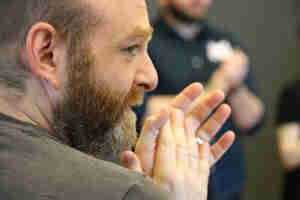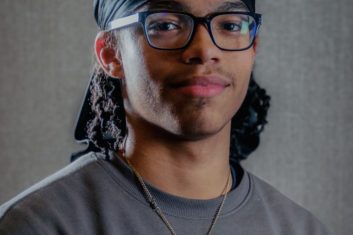Editor’s Note: Even as we’re full speed ahead with our TAP 2018-19 trainees, we’re still reveling in the reflections of our 2017-18 participants. Over the next several weeks, we’ll be sharing several blogs authored by our now-alums. These blogs are both delightful throwbacks, as well as hints about what might be ahead for this year’s trainees!
In spring 2018, Community-Word Project artist Sebastian Cruz co-facilitated a seminar, Teaching for English Language Learners through Dance, Movement & Music, at Carnegie Hall. The seminar was part of the TAP Cohort‘s Elective Seminar series. In the course of an afternoon, Cruz took language out of the equation and brought it home to the classroom again.


Take, for example, the old children’s game, “Whispers.” One person whispers a word in the ear of the next person. The whisper goes around a circle, and the word that returns is never the one that came out. With its linguistic demands, however, “Whispers” might be hard for students new to the classroom language. Cruz’s version was language-free: Sit in a circle, hold hands, and pass a squeezed rhythm around the room. With no need for words, this game made it safe to play, to interact, and to connect with a roomful of strangers: perfect for bringing bilingual or multilingual students fully into the room.
Building on that exercise, Cruz taught a competitive version. In an elimination round, students sat with their eyes closed, and passed a clap around the circle. Cruz stood in the center, observing as rhythms moved around him. Students who caught and passed the pulse stayed in the game. Students who missed the beat were out.
For the next round, one trainee took the role of referee and a position in the middle of the circle. Students who weren’t comfortable with competing were allowed to ask eliminated classmates to take their places, and to step to the side and learn through observation. Music mattered, but autonomy and community came first.


Making the game more complex, students were encouraged to clap short rhythmic patterns and pass them along. The rules were simple: create, repeat, repeat, repeat … Keep your eyes – and your ears – open.
Unsurprisingly, musicians (with imaginations that stretched to 5/4 patterns) were the last survivors. The last two traded increasingly complex patterns until one was left sitting in a rapt and breathless room. The potential for classroom use was undeniable.
Encouraging creativity, Cruz then invited students to work in quartets. He directed them to use voice their voices to make a band with one playing rhythm, one bass, one rhythmic guitar, and one melody. Group leaders directed crescendos, diminuendos, and caesuras, and decided when and how the sound would end. Every group took the basics and made sounds that were unique, complex, and full of personality.
By the end of the seminar, English-speaking participants were asking for terms in Spanish, so they could give choreographic cheers and direction in a new language. In a class about teaching bilingual students, every trainee had made discoveries about how to play and learn, in the language of music or a no-longer-completely-foreign tongue.


Seánan Forbes is a multi-disciplinary artist and TAP alum.



